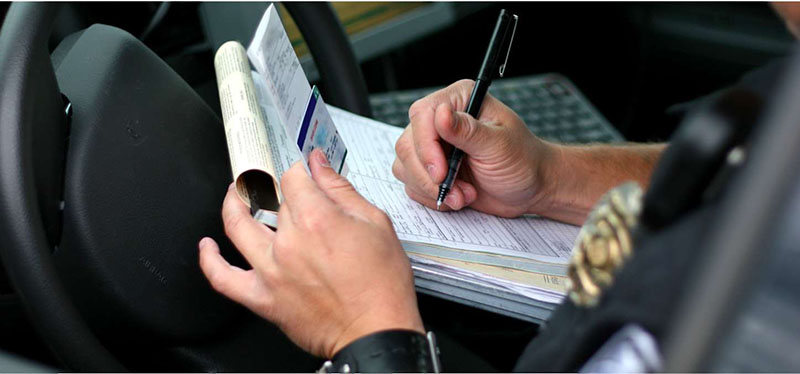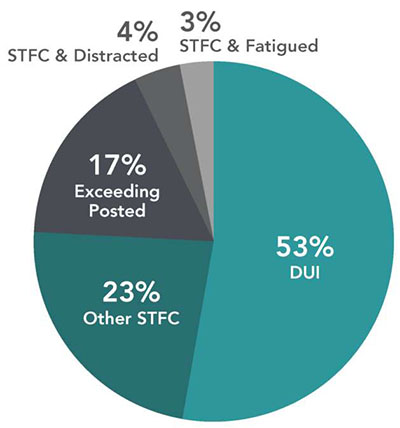U.S. Department of Transportation
Federal Highway Administration
1200 New Jersey Avenue, SE
Washington, DC 20590
202-366-4000
(Note: This document has been converted from the original document to 508-compliant HTML. The formatting has been adjusted for 508 compliance, but all the original text content is included, plus additional text descriptions for the images, photos and/or diagrams have been provided below.)
| ISSUE | STRATEGIES | TAKEAWAYS |
|---|---|---|
|
|
|
Speed Too Fast for Conditions (STFC) is a field provided on most agency crash forms. The intent is to label scenarios where a driver was traveling below the posted speed limit but the speed at the time of the crash was not appropriate for prevailing environmental conditions and was a contributor to the crash. However, significant variations exist in interpreting the definition of the environment when coding crash forms. As a result, it is often left to the attending officer's interpretation.
In Arizona, historically STFC was defined as "Traveling at a speed that was unsafe for the road, weather, traffic or other environmental conditions at the time." In many cases, an officer would include the behavioral or human environment and could interpret driver incapacity (Driving Under the Influence (DUI), impaired, distracted, fatigued) as a condition that would warrant traveling at a lower speed regardless of actual roadway conditions. For instance, a drunk driver on dry daytime roads traveling under the speed limit could be coded as Speed Too Fast for Conditions if the officer felt the state of impairment warranted a lower speed. Depending on the attending officer's interpretation, there may be scenarios in which no speed is safe for conditions1. While it is important to address these crashes, solutions should focus on the root cause of the crash when feasible. Countermeasures geared specifically towards speeding, such as Dynamic Speed Feedback Signs (DSFS), lane narrowing, or use of landscaping, may be less effective when the driver is impaired. Rather areas with a high number of impaired crashes should be targeted with countermeasures that address the impairment, such as enforcement.

Speeding Vehicle. Source: Getty Images
Around one-third of Arizona fatal crashes were coded as speeding related between 2012 and 2016 and over 53 percent of those fatal crashes were also coded as impaired but below the posted speed limit1,2,3.
Correcting the interpretation of behavioral conditions would have removed crashes such as DUI (53 percent), distracted (4 percent), sleeping or fatigued (3 percent) that were not marked as exceeding the posted limit and where no speed would have otherwise been reasonable. This would have reduced the number of crashes during this period that were coded as speeding related (Speed exceeded the limit and STFC) from over 33 percent down to approximately 11 percent of total fatalities.
As a result, Arizona made the decision to address the issue by providing clear instructions and training that would remove DUI and other impaired crashes from the category of STFC. In this manner locations with actual speeding-related issues can be better targeted1.

Officer uses driver information to complete a traffic ticket. Source: Getty Images
Arizona adapted coding instructions for their crash form for the field Speed Too Fast for Conditions. The new instructions define STFC as the following:
"Traveling at a speed that was unsafe for the road, weather, traffic or other environmental conditions at the time. This does not include behavioral conditions such as distraction, impairment, fatigue, falling asleep or other violations that would otherwise make any speed unreasonable".
Based on the new instructions, crashes where impairment, fatigue, or other behavioral issues are the main contributor are coded as impairment. Crashes with an impaired driver can still be coded "Exceeding the Posted Speed Limit" when both conditions are met1.
In the future, officers and agencies will be able to use the data to identify locations with a high number of speeding-related crashes which actually represent a speeding problem. In this manner, automated enforcement and other speeding-related countermeasures can be applied and are expected to be more effective. For instance, ADOT is evaluating speed limit decals on State Route 347 where a review of crash reports indicated drivers were cited as STFC in more than half of crashes along this section of roadway4.

Fatal Crashes in Arizona. Data Source: King, 2018; ADOT, 2016
Percentage of fatal crashes coded as STFC decreased by more than 1/3 after changing the crash form instructions.
Addressing crash contributing factors to target countermeasures – Although both Speed Too Fast for Conditions and Exceeded the Posted Speed Limit represent important safety issues, in most cases they represent two vastly different situations. In many cases, STFCs are either impaired drivers or weather related situations. Since neither scenario is usually tied to a specific roadway section, it is difficult to target site-based countermeasures. More importantly, many speed management countermeasures may not be suited to the problem. For instance, DSFS or safety cameras are set to activate at speed thresholds set for dry conditions. As a result, an impaired driver involved in a crash or a driver traveling too fast for weather conditions could be coded by the attending office as STFC yet be traveling below the thresholds set to activate DSFS or safety cameras. This may lead to utilizing countermeasures which would have no impact on these types of crashes. Other speed management countermeasures, such as lane narrowing or pavement markings, may similarly not be well suited in these situations if drivers are cognitively impaired.
Arizona came to this realization as they considered how speeding-related crashes could be addressed. As a result, they found a solution that allows them to focus on the root cause of the crash when feasible. The ability to parse crashes by situations where speeding-related countermeasures are effective versus situations, such as impaired driving, where countermeasures such as targeted enforcement are effective is important because it allows agencies to better focus resources.
Consistency in coding – Arizona also made the decision to update the crash form rather than relying solely on additional training for officers in how to better code STFC. This was successful since, even with training, significant variation can exist in how officers interpret fields on a crash form. As a result, the updated crash form provides more consistency.
Case Study 6: Noteworthy Speed Management Practices – FHWA-SA-20-082
